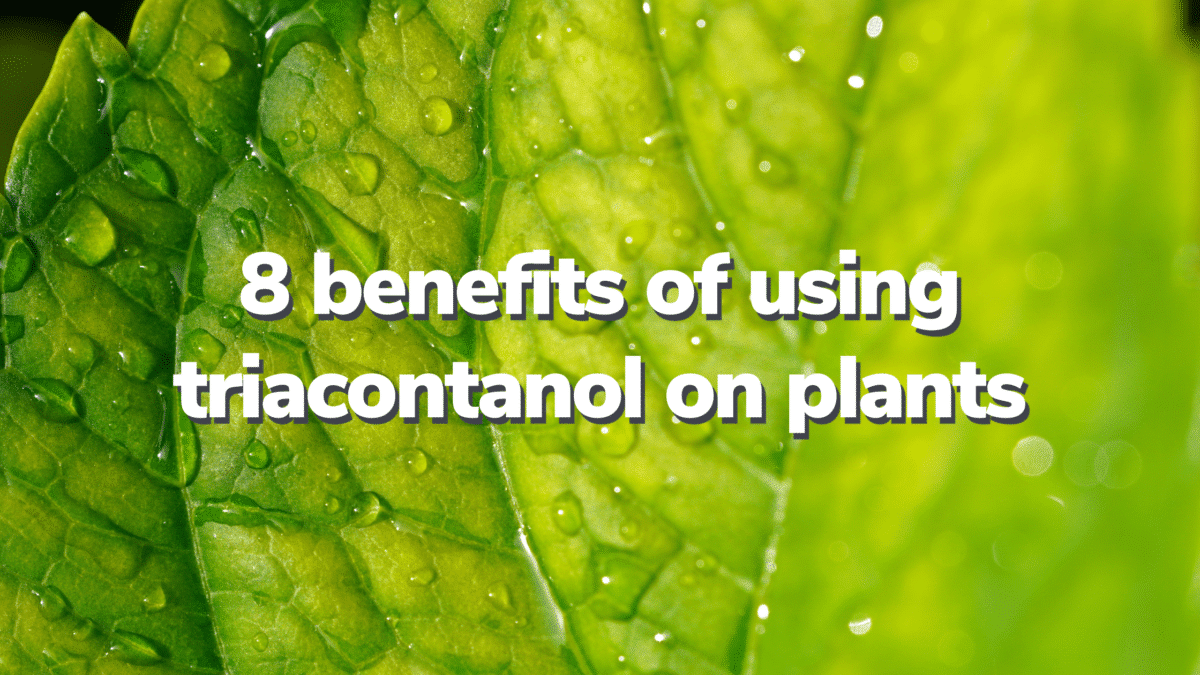In agriculture, where every gram of yield matters, farmers are constantly on the lookout for innovative solutions to enhance productivity and crop quality. One such solution that has garnered attention in recent years is triacontanol, a natural plant growth regulator. Here’s how to use triacontanol on plants and the benefits of doing so.
What is triacontanol?
Triacontanol, a long-chain fatty alcohol, is a naturally occurring compound found in the waxy coating of various plants, including alfalfa, wheat, and rice. Despite its humble origins, triacontanol packs a powerful punch when it comes to promoting plant growth and development. Numerous scientific studies have elucidated its mechanisms of action and demonstrated its efficacy in enhancing crop yields and quality.
8 benefits of using triacontanol on plants
1. Enhancing photosynthesis and chlorophyll production
One of the key benefits of triacontanol lies in its ability to enhance photosynthesis—the fundamental process by which plants convert light energy into chemical energy. Studies have shown that triacontanol stimulates chlorophyll synthesis, leading to increased photosynthetic efficiency and carbon dioxide assimilation. This translates into improved plant vigour and brix levels, higher biomass accumulation, and ultimately, greater yields for farmers.
According to Graeme Sait of Nutri-Tech Solutions, triacontanol is the most productive growth stimulant ever discovered. “The main growth response is based on its capacity to enhance the rate of photosynthesis. The effect of this growth stimulant was already well documented in 1985. In a series of trials, the average chlorophyll increase was 37%. It has been linked to the improved performance of several phosphate-based enzymes.”
2. Accelerating growth and development
Research has revealed that triacontanol promotes cell division, elongation, and differentiation, resulting in faster germination, robust root development, and vigorous shoot growth. By accelerating growth and development processes, triacontanol enables plants to reach their full genetic potential, thereby maximising productivity in agricultural systems.
3. Stress resistance and hormonal regulation
Studies have shown how triacontanol opens up new approaches to plant resistance against various environmental cues like drought, heatwaves, pest infestations and disease outbreaks. It has great potential to nullify stress-induced toxicity by modulating the stress-accrued alterations in crop plants’ morpho-physiological, biochemical, and developmental processes.
Triacontanol has been shown to play a crucial role in enhancing plant resilience to these stressors by regulating the synthesis of plant hormones such as abscisic acid (ABA) and cytokinins. By modulating hormonal pathways, triacontanol helps plants cope with adverse conditions, maintain water balance, and mount effective defence responses against pests and pathogens.
4. Improved nutrient uptake and efficiency
Efficient nutrient uptake is essential for healthy plant growth and development. Studies have demonstrated that triacontanol enhances the permeability of plant cell membranes, facilitating the uptake and utilisation of essential minerals and nutrients from the soil. This improves plant nutrition and reduces fertiliser requirements, making agricultural systems more sustainable and environmentally friendly.
5. Softening the impact of salt stress
Salt stress poses a significant challenge to crop production, particularly in regions with high soil salinity. However, studies have shown that triacontanol can mitigate the adverse effects of salt stress on plants by increasing the levels of calcium and potassium while reducing sodium accumulation. Triacontanol also acts as a scavenger of free radicals associated with salt stress, thereby preserving plant health and productivity even in challenging environments.
6. Increasing plant biomass and protein levels
Greater biomass and protein content in crops enhance yield potential and contribute to improved nutritional quality. Triacontanol has been found to increase plant biomass by enhancing photosynthetic efficiency and nutrient uptake. Studies have also revealed significant increases in leaf levels of nitrate reductase enzyme following triacontanol application, leading to higher protein synthesis and enhanced plant immunity.
7. Optimising yield and quality
Triacontanol has been shown to play a pivotal role in achieving better yields by rapidly triggering the production of secondary messengers that enhance biochemical processes related to yield and quality. From increased dry weight to higher levels of free amino acids and soluble proteins, triacontanol contributes to both quantity and quality aspects of crop production. In field trials, it has increased rice yields by 20-30%, wheat by 15-20%, and soybeans by 10-15%.
8. Enhancing sustainable farming practices
By enhancing photosynthesis, accelerating growth, and improving stress tolerance in plants, triacontanol enables farmers to achieve higher yields while minimising chemical inputs. Its ability to optimise nutrient uptake and utilisation further contributes to resource efficiency and environmental stewardship.
Triacontanol also promotes the development of healthier, more resilient crops, reducing reliance on synthetic pesticides and fertilisers. As a natural and environmentally friendly plant growth regulator, triacontanol embodies the principles of sustainable agriculture, empowering farmers to cultivate resilient food systems that are both productive and ecologically sound.
How to use triacontanol on plants
Triacontanol enhances plant growth when applied exogenously at relatively low concentration. Implementing triacontanol in farming practices is relatively straightforward. It can be applied through foliar sprays or soil treatments, depending on the crop and growth stage.
Foliar spraying is particularly effective for quick absorption and utilization by plants, while soil treatments provide a more sustained release of the compound, ensuring long-term benefits for crop growth and development. Triacontanol can also be added to the soil around the plant. This allows the plants to absorb the compound through their roots, providing a more long-term solution.
For best results, triacontanol should be applied before or during periods of rapid growth, such as before flowering or fruiting, and applied to young seedlings to encourage rapid and uniform growth.
Looking to optimise crop productivity and quality sustainably?
Backed by scientific studies and real-world applications, triacontanol offers a holistic approach to enhancing plant growth, resilience, and nutrient efficiency.
Interested in learning more or importing triacontanol? We’d love to hear from you!

